Are you struggling to find a reliable supplier for your eco-friendly products? It can feel like a maze of unverified claims and inconsistent quality. You need a partner you can trust to deliver certified, high-quality goods that align with your brand’s values, but finding one feels like a huge risk.
The best source for eco-products is a specialized B2B partner or direct manufacturer that offers certified, transparent, and scalable solutions. Look for suppliers who can provide proof of certifications like BPI, TUV Austria, FDA, and LFGB. A great source acts as a partner, understanding your specific needs for materials like bagasse or PLA, customization options, and global logistics. They make sourcing sustainable products simple and secure, ensuring quality and compliance every step of the way.
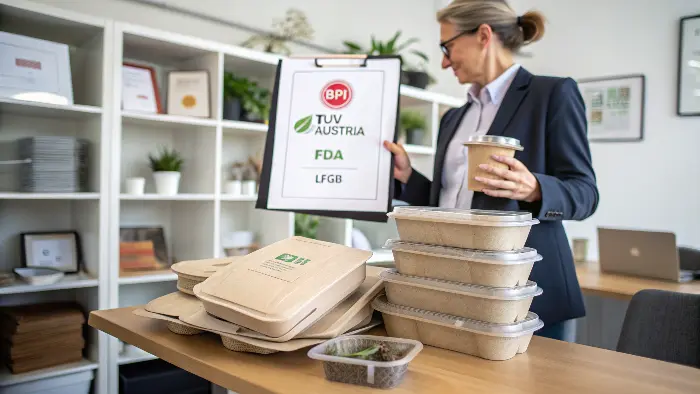
Finding the right partner is more than just a transaction. It’s about building a relationship that supports your company’s mission. I’ve spent years in this industry, and I’ve seen firsthand how the right supplier can make or break a brand’s sustainability goals. It’s a journey that requires careful questions and clear criteria. Let’s walk through how you can identify the perfect source for your business.
How to find eco-friendly products?
Searching online for "eco-friendly products" gives you millions of results, but how many are legitimate? You spend hours vetting potential suppliers, requesting samples, and checking certifications, only to find dead ends. It’s exhausting and slows down your progress toward your sustainability goals, leaving you feeling stuck and frustrated.
To find eco-friendly products efficiently, start by defining your specific needs, including materials, certifications (e.g., BPI, ASTM D6400), and volume. Then, explore specialized B2B platforms like Ecosourcecn, attend industry trade shows, and ask for referrals. The key is to create a shortlist and then rigorously vet each supplier. Ask for their certification documents, order samples for testing, and discuss their supply chain transparency to ensure they are a legitimate and reliable partner.
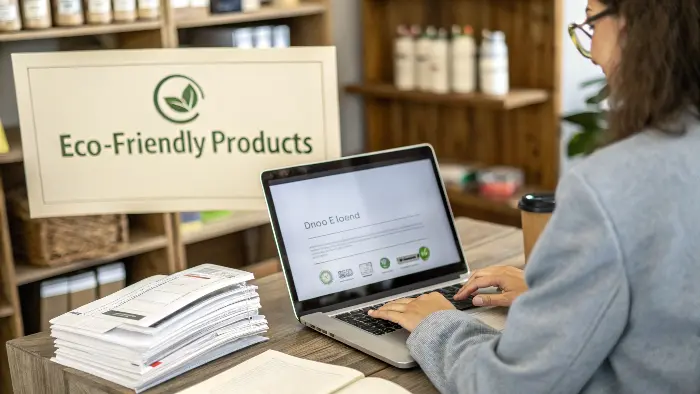
Finding the right products is a systematic process, not a game of chance. I learned early on that a structured approach saves immense time and protects my clients from costly mistakes. It’s about knowing what questions to ask and where to look. Let’s break down the exact steps I use to source and verify products for businesses around the world. It all starts with a clear plan.
The Vetting Process: A Step-by-Step Guide
First, you need to define exactly what you’re looking for. Are you sourcing compostable food containers? Biodegradable mailers? PLA cutlery? Be specific about the material, size, and intended use. This clarity will be your filter for all potential suppliers.
Next, you must create a list of non-negotiable requirements. For most of my clients in North America and Europe, this list includes specific certifications. You can’t just take a supplier’s word for it. You need proof.
Here is a simple checklist you can use when vetting a new supplier:
| Vetting Step | Key Action | What to Look For |
|---|---|---|
| 1. Certification | Request copies of all relevant certificates. | Look for EN13432, ASTM D6400, BPI, TUV Austria (OK compost HOME/INDUSTRIAL), FDA, and LFGB. Verify the certificate number and valid dates. |
| 2. Samples | Order product samples. | Test the product for its intended use. Does the bagasse container hold hot liquids without leaking? Is the CPLA cutlery strong enough? |
| 3. Communication | Assess their responsiveness and expertise. | Do they answer your technical questions clearly? Do they understand your market’s compliance needs? Are they transparent about their production process? |
| 4. Social Proof | Ask for case studies or client testimonials. | Look for experience with companies in your region (e.g., Canada, USA, UK). This shows they understand the logistics and customs requirements. |
Once you have this information, you can confidently compare potential partners. Remember a few years ago, I was working with a new client in Canada, much like Jacky, who was burned by a supplier claiming their products were "100% compostable." After some digging, we found the certification had expired years ago. This simple vetting process saved them from a massive compliance headache. Don’t skip these steps.
Which are the best eco products?
You want to switch to sustainable products, but the options are overwhelming. You see terms like PLA, CPLA, bagasse, and kraft paper, but what do they mean for your business? Choosing the wrong material can lead to unhappy customers, operational issues, and wasted investment. It’s a high-stakes decision.
The "best" eco products are those that fit their specific purpose while minimizing environmental impact. For hot foods and sturdiness, bagasse (sugarcane) containers are excellent. For clear cold cups and lids, PLA is the industry standard. For strong, heat-resistant cutlery, CPLA is the superior choice. For versatile bags and boxes, FSC-certified kraft paper is a fantastic, recyclable, and often compostable option. The best choice always depends on the application.
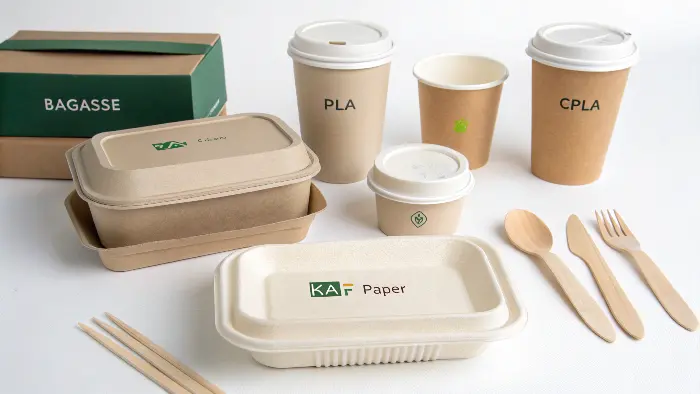
Choosing the right product is about matching the material to the function. It’s a practical decision, not just an environmental one. I’ve helped countless businesses navigate these choices, preventing costly mismatches like putting hot soup in a standard PLA cup. Understanding the core strengths of each material is the key to making a smart, sustainable choice for your customers and your bottom line.
Matching Products to Your Business Needs
Let’s categorize the most common eco-friendly products. This will help you see where each one shines and how it can fit into your operations. Think of this as your starting guide to building a sustainable product portfolio.
For Food Service & Restaurants
If you’re in the food industry, your needs are demanding. Products must be food-safe, functional, and able to handle a wide range of temperatures.
- Bagasse Tableware: This is my top recommendation for hot food applications. Bagasse is the fibrous pulp left over after extracting juice from sugarcane.
- Products: Clamshell containers, plates, bowls.
- Why it’s great: It’s microwave-safe, freezer-safe, and handles hot, wet, and oily foods brilliantly. It’s a byproduct, turning agricultural waste into a valuable resource. It’s certified compostable.
- CPLA Cutlery: Standard PLA can warp with heat. Crystallized PLA (CPLA) is the solution.
- Products: Forks, knives, spoons.
- Why it’s great: It has a high heat resistance (up to 185°F or 85°C), making it perfect for hot soups, coffee, and meals. It’s strong and doesn’t snap easily.
For Cafes & Takeaway Drinks
Cold drinks and grab-and-go items have different requirements, where clarity and convenience are key.
- PLA Cups & Lids: PLA (Polylactic Acid) is a bioplastic derived from plant starches like corn.
- Products: Clear cups for iced coffee, smoothies, and juices.
- Why it’s great: It’s transparent, offering a premium look similar to traditional plastic. It’s commercially compostable and made from renewable resources.
For Packaging & Shipping
For e-commerce and retail, the focus is on durable, lightweight, and brandable packaging.
- Kraft Paper Products: Made from wood pulp, kraft paper is a classic for a reason.
- Products: Paper bags, mailers, wrapping paper, cardboard boxes.
- Why it’s great: It’s strong, recyclable, and often made from recycled content. Look for FSC (Forest Stewardship Council) certification to ensure the pulp comes from responsibly managed forests.
Choosing the right product means you deliver a better experience for your customer and ensure your sustainability claims are backed by performance.
What are the best eco items?
You’ve identified potential product categories, but now you need to compare the raw materials. Is PLA better than bagasse? When should you use kraft paper instead of a bioplastic? Making the wrong choice can affect everything from performance and cost to your brand’s compostability message. You need a clear comparison.
The best eco items are chosen based on material properties. Bagasse is best for hot, durable food containers as it comes from a waste stream. PLA is ideal for clear cold cups and packaging where transparency is key. Kraft paper is the most versatile for bags and boxes due to its strength and recyclability. Each material serves a different best-use case, so the "best" item is the one that aligns performance with its end-of-life plan.
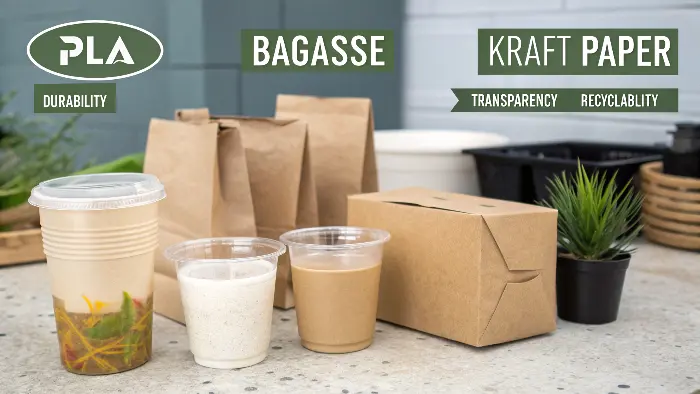
I always tell my clients, "Don’t pick a favorite material, pick the right tool for the job." I once had a cafe owner who loved the idea of PLA and wanted to use it for everything. We had to have a practical chat about CPLA for their hot coffee stirrers to avoid melted plastic and unhappy customers. Understanding the nuances is what sets successful eco-brands apart. Let’s put these materials head-to-head.
Material Showdown: PLA vs. Bagasse vs. Kraft Paper
To make an informed decision, you need to see the pros and cons side-by-side. As a packaging specialist like Jacky would appreciate, the details matter. Let’s break it down into a simple, actionable table. This is the exact kind of analysis we do at Ecosourcecn before recommending a solution.
| Feature | PLA (Polylactic Acid) | Bagasse (Sugarcane Pulp) | Kraft Paper |
|---|---|---|---|
| Raw Material | Corn starch or other plant sugars (Renewable resource) | Sugarcane fiber (Agricultural waste product) | Wood pulp (Renewable, look for FSC certification) |
| Best Use Cases | Clear cold cups, salad containers, deli pots, packaging film. | Hot food containers, plates, bowls, clamshells. | Shopping bags, takeaway food boxes, mailers, wrapping. |
| Pros | – High clarity and gloss – Looks like traditional plastic – Certified commercially compostable |
– Excellent for hot & oily foods – Microwave and freezer safe – Made from a waste stream – Certified commercially compostable |
– Strong and durable – Widely recyclable – Often home compostable (if uncoated) – Great for printing and branding |
| Cons | – Low heat tolerance (warps >110°F/43°C) – Requires industrial composting facility – Can be brittle |
– Opaque material – Not suitable for clear-view needs – Can absorb a lot of moisture over time |
– Not waterproof (unless coated, which affects compostability) – Not transparent |
| End-of-Life | Industrial Composting | Industrial Composting | Recycling or Composting (if uncoated) |
This comparison makes it clear: there is no single "best" material. The best choice is a strategic one. If you’re selling fresh salads and want customers to see the vibrant ingredients, PLA is the winner. If you’re a food truck serving hot curry, bagasse is the only sensible choice. And for the bag you put it all in, kraft paper is perfect. A truly sustainable brand uses a mix of these materials, applying each one where it performs best. This thoughtful approach shows customers you’ve done your homework.
What is the most eco-friendly source for food service products?
You need packaging for your food business, but the stakes are high. Not only does it have to be eco-friendly, but it must be food-safe. Sourcing from a supplier that doesn’t understand regulations like FDA or LFGB could lead to product recalls, legal issues, and a complete loss of customer trust.
The most eco-friendly source for food service products is a certified manufacturer or B2B platform that specializes in food-grade materials. They must provide documentation for food contact safety (like FDA and LFGB compliance) alongside their compostability certifications (like BPI and EN13432). A reliable source offers material expertise, traceability, and understands the critical importance of health and safety in the food industry.
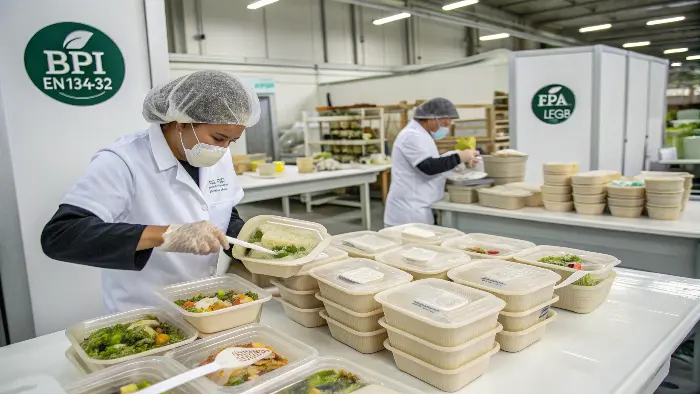
This is the most critical point for anyone in the food business. I can’t stress this enough: eco-friendly is only half the equation. Food-safe is the other, non-negotiable half. I’ve built my company, Ecosourcecn, on this principle. A "green" product that isn’t safe for contact with food is not a solution—it’s a liability. Finding a source that prioritizes both is the key to protecting your business and your customers.
Beyond "Green": The Food-Safe Priority
When sourcing for food service, your vetting process needs an extra layer of scrutiny. The supplier isn’t just selling you a box; they are providing a key component of your food delivery system. Here’s what you must demand from a sourcing partner in this space.
1. Unquestionable Compliance and Certification
This goes beyond the standard compostability certs. Your supplier must be an expert in global food-contact regulations.
- FDA (U.S. Food and Drug Administration): Essential for products sold in the United States. It ensures the material is safe for contact with food.
- LFGB (Lebensmittel-, Bedarfsgegenstände- und Futtermittelgesetzbuch): This is the German and European standard. It’s often considered stricter than FDA, especially concerning chemicals and heavy metals. Seeing an LFGB certification is a very good sign of quality.
When I speak with a potential supplier, my first question is, "Can you provide the FDA and LFGB compliance reports for this bagasse container?" If they hesitate or can’t produce it, the conversation ends.
2. Deep Material Expertise
A great source partner understands the science behind their products. They can tell you the exact temperature at which a CPLA fork will begin to soften, or how long a bagasse bowl can hold soup before any fiber integrity is lost. This isn’t just trivia; it’s vital information for your operations and for training your staff. I remember working with a client to create custom-branded PLA cups. The supplier we partnered with advised us to slightly thicken the cup wall to better handle the automated dispensing machines in their cafes. That small suggestion saved the client thousands in potential operational jams.
3. Traceability and Quality Control
Where did the raw material come from? What quality control checks are performed during production? A top-tier source can answer these questions. They should have a clear process for inspecting products before they are shipped. This ensures consistency from batch to batch, protecting your brand’s reputation. Ask about their QC process. Do they check for defects? Do they test for strength and durability? A good partner will be proud to share this information.
Choosing a source for food service products is a decision that impacts your entire business. Find a partner who is as obsessed with safety and quality as you are.
Conclusion
Finding the best source for eco-products comes down to a clear, simple process. It’s about defining your needs, vetting suppliers for certifications like BPI and FDA, and matching the right material—like bagasse, PLA, or paper—to the right job. A true partner will guide you through this, ensuring your products are compliant, high-quality, and genuinely sustainable.


